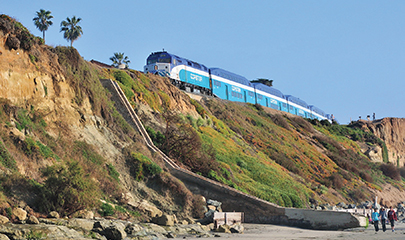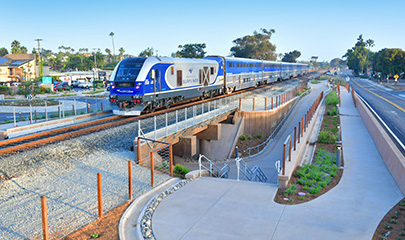Construction Notice: Crews are working on stabilizing the retaining wall along Santa Fe Street. One lane of traffic near Damon Avenue will be closed during construction until fall 2025. Learn more about the project.
The 351-mile Los Angeles-San Diego-San Luis Obispo (LOSSAN) Corridor is vital for passenger, freight, and military movement through the San Diego region and beyond. In FY 2023, passengers boarded trains on this corridor 3.74 million times. As one of the busiest intercity rail corridors in the nation and the only rail connection between San Diego and the rest of the state and nation, the LOSSAN Corridor supports national and international commerce, including a growing crossborder trade market with Mexico. Every year, trains on this corridor carry billions of dollars' worth of goods.
In Our Region
The San Diego LOSSAN Corridor spans the 60 miles between our border with Orange County and Santa Fe Depot in Downtown San Diego. It passes over six coastal lagoons, along the coastal bluffs, and through Camp Pendleton and six cities (Oceanside, Carlsbad, Encinitas, Solana Beach, Del Mar, and San Diego). Operations on the line include approximately 50 trains per day from Amtrak’s Pacific Surfliner, the Southern California Regional Rail Authority’s Metrolink, North County Transit District’s COASTER and SPRINTER, and Union Pacific and BNSF Railway freight rail services.
What We’re Doing
Because this rail line is so essential, we are working on short- and long-term responses to landslides, erosion, and seismic activity which have caused collapses along the coastal bluffs in Del Mar and temporary shutdowns of the rail line. Over the next two decades, SANDAG plans to construct nearly $1 billion in improvements to keep the corridor safe, including double tracking, stabilization of the Del Mar Bluffs, and rail line relocation.
To date, we’ve double tracked 75% of the regional segment, completed four bluff stabilization projects, and started to study the options for rail relocation. Other infrastructure improvements include bridge and track replacements, new platforms, pedestrian undercrossings, and other safety and operational enhancements.
Improving resiliency and safety tops the list of reasons we are identifying and implementing solutions. Additionally, these solutions further the goals of the California State Rail Plan and SANDAG Regional Plan to increase track capacity, reduce travel times, and provide more service. The resulting increase in ridership will support local, state, and national economies and help us meet greenhouse gas emission reduction targets set by the California Air Resources Board.
For more information, contact the SANDAG LOSSAN project team at lossancorridor@sandag.org or call our hotline at 858.549.RAIL (7245).























